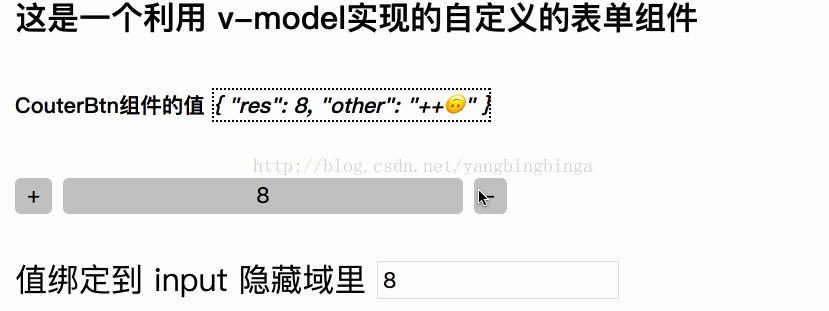这篇文章主要介绍怎么利用Vue v-model实现一个自定义的表单组件,文中介绍的非常详细,具有一定的参考价值,感兴趣的小伙伴们一定要看完!
Vue是一款友好的、多用途且高性能的JavaScript框架,使用vue可以创建可维护性和可测试性更强的代码库,Vue允许可以将一个网页分割成可复用的组件,每个组件都包含属于自己的HTML、CSS、JavaScript,以用来渲染网页中相应的地方,所以越来越多的前端开发者使用vue。
功能描述:
通过点击按钮,可以增减购物数量
组件名称是 CouterBtn
最终效果如下

我们使用 vue-cli搭建基本的开发环境,这也是最快的进行 .vue组件开发的方式
对于入口组件 App.vue (可以暂时忽略其他细节,我们的重点是如何写组件)
App.vue
<template>
<div id="app">
<h5>这是一个利用 v-model实现的自定义的表单组件</h5>
<h7>CouterBtn组件的值 <i> {{ btnValue }} </i></h7>
5. <counter-btn v-model="btnValue"></counter-btn>
<form class="" action="/add" method="post">
<!-- 真实情况请将 type改为hidden -->
<label for="count">值绑定到 input 隐藏域里</label>
<input type="text" name="count" :value="btnValue.res" id="count">
10. </form>
</div>
</template>
<script>
import CounterBtn from './components/CouterBtn.vue'
15. export default {
data() {
return {
btnValue: {}
}
20. },
components: {
CounterBtn
}
}
25. </script>
<style lang="stylus">
h7 i
border 1px dotted
form
30. margin-top 20px
padding 20px
border 1px dotted #ccc
label
vertical-align: middle
35. </style>下面我来对 App.vue中的一些代码进行一些说明,根据代码行数来说明
4 : 我们使用 {{ btnValue }}来获取自定义组件 counter-btn的值, 这里仅仅是展示效果用
5: 我们使用了counter-btn ,自定义的组件
9: 我们将自定义组件的值,绑定到我们的表单组件 input中去, 在真实的情况下, 此 input的类型可能为 hidden类型
21: 由于我们需要在App.vue组件中使用我们自定义的组件 counter-btn,所以需要使用 components注册组件, 这里还使用了 ES6的对象解构
26: 我们使用CSS预处理器为stylus, 前提是你的 node_modules中要安装此npm包和loader,vue-cli已经帮我们处理好了stylus的编译; 根据个人情况选择
我们自己设计的组件通过 v-model,把组件内部的值传给了它所绑定的值
下面我们来看看我们的组件的实现
CounterBtn.vue
<template>
<div class="coutter-wrapper">
<button type="button" @click="plus">+</button>
<button type="button">{{ result }}</button>
5. <button type="button" @click="minus">-</button>
</div>
</template>
<script>
export default {
10. methods: {
minus() {
this.result--;
this.$emit('input', {res: this.result, other: '--'})
},
15. plus() {
this.result++;
this.$emit('input', {res: this.result, other: '++'})
}
},
20. data() {
return {
result: 0,
}
}
25. }
</script>
<style lang="stylus" scoped>
button
border 0
30. outline 0
border-radius 3px
button:nth-child(2)
width 200px
</style>我们可以看到组件的实现非常简单, 3个button搞定; 这里最关键的代码是
this.$emit('input', {res: this.result, other: '++'})
通过 触发 input事件和自定的数据来实现把数据暴露给 v-model绑定的属性值
以上是“怎么利用Vue v-model实现一个自定义的表单组件”这篇文章的所有内容,感谢各位的阅读!希望分享的内容对大家有帮助,更多相关知识,欢迎关注亿速云行业资讯频道!
亿速云「云服务器」,即开即用、新一代英特尔至强铂金CPU、三副本存储NVMe SSD云盘,价格低至29元/月。点击查看>>
免责声明:本站发布的内容(图片、视频和文字)以原创、转载和分享为主,文章观点不代表本网站立场,如果涉及侵权请联系站长邮箱:is@yisu.com进行举报,并提供相关证据,一经查实,将立刻删除涉嫌侵权内容。